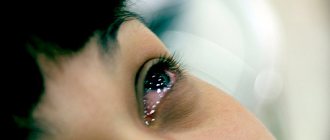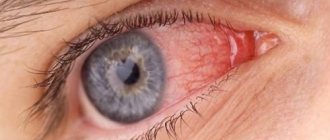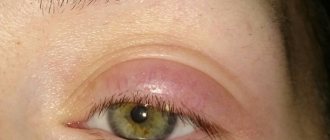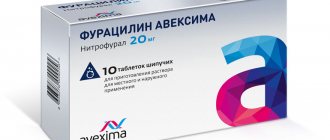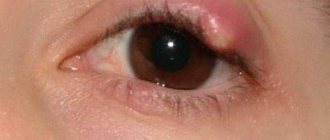Medical indications
Inflammation of the eyes, which covers the mucous membrane, develops due to the entry of viruses, fungi, and bacteria into the organs of vision.
The pathogen can cause colds, flu, and acute respiratory infections. Ophthalmologists recommend treating conjunctivitis in adults and children with drops of various effects. Conjunctivitis
Taking into account the classification of the causative agent of the infectious process, the following agents can be dripped into the eyes:
- viral;
- allergic;
- bacterial.
Antiviral drops for conjunctivitis act on cells, destroying the pathogen.
If 1 eye is affected, it is instilled carefully so that a drop of the solution does not fall into the other.
The following drugs help against the viral form of the disease:
- Florenal ─ quickly neutralizes the virus.
- Tebrofen ─ used 3 times daily.
- Gludantan ─ effectively fights the virus without causing side effects. Treatment of complex conjunctivitis involves repeated doses of the drug (5-6 times daily).
- Poludan ─ is prescribed for blepharoconjunctivitis.
- Dexamethasone ─ is not recommended for pregnant women.
Antibiotic eye drops for conjunctivitis include Oftalmoferon and Lokferon. They destroy the pathogen, helping to increase the immunity of the mucous membrane. If the disease is bacterial in nature, then antimicrobial eye drops are prescribed. This form of the disease is characterized by the appearance of pus and mucus, and 2 eyes are affected.
How to identify viral conjunctivitis
Determining the patient's condition is carried out in several stages:
- Collection of complaints. The patient says that his eyes become watery, his throat hurts, his eyes become very red and inflamed. This causes pain and discomfort.
- General inspection. The doctor discovers a hyperemic cornea, possibly minor hemorrhage. There is no discharge of pus. Under the influence of a slit lamp, the patient cannot open his eyes.
- PCR technique. A swab is taken from the patient's eyes and sent to the laboratory. It is examined on a semi-automatic analyzer that detects the genes of the virus. Using the technique, herpes, adenovirus, and influenza are detected.
Additionally, the doctor prescribes bacterial culture and microscopy. Using techniques, the disease is differentiated and distinguished from other forms of conjunctivitis.
Eye drops for conjunctivitis with bacterial infection
Treatment of bacterial conjunctivitis involves taking antibiotics, presented in the form of the following solutions:
- Albucid 20% or solution 30% ─ the attending physician selects the concentration taking into account the patient’s age. It is better for children to drip a 20% solution, as it does not cause a burning sensation, and for adults it is better to use a 30% solution. The drug is taken 3 times a day. It relieves redness and swelling well.
- ─ used 5 times daily. These drops for the treatment of conjunctivitis have an antiseptic effect.
- Norsulfazole is used 4 times a day. The eye is pre-washed.
- Levomycetin ─ has an antibacterial effect. Used 4 times a day.
- Vigamox ─ is prescribed to elderly patients.
- Floxal ─ has an antimicrobial effect. Instilled in 2 eyes 5 times a day.
- Gentomycin ─ drops for conjunctivitis have an antimicrobial effect.
- Zinc sulfate is prescribed as an effective antibacterial solution for adults.
For chronic conjunctivitis, the following drops are prescribed: 1% solution of potassium permanganate, silver nitrate. You can use herbal remedies (decoction of string, chamomile and calendula). The allergic form of the disease is associated with the negative effect of an aggressive agent on the membrane of the eyes.
What drops are used to combat allergic conjunctivitis? The list of products is selected by the doctor, taking into account the type of allergen.
The patient uses drops for external use (Cortisone, Claritin, Lacrisifine) and antihistamines. Antibacterial drugs are prescribed Tobrex, Oftadek. Calcium chloride 10%, Diphenhydramine tablets are used intravenously.
- Levomycetin eye drops are drugs with a wide range of effects. Their use negatively affects the development of gram-negative and gram-positive inflammatory pathogens. The components of the drug act locally and penetrate into the bloodstream in small quantities, so Levomycetin is not used for problems with hematopoiesis, kidney and liver pathologies. The drug can be used in the treatment of conjunctivitis in children starting from the age of two. Levomycetin drops for eyes also have the most affordable price.
- Tobrex eye drops contain an antibiotic from the aminoglycoside group, which has a wide spectrum of antibacterial action. Tobrex can be used to treat conjunctivitis caused by streptococci, diphtheria bacteria, E. coli, and staphylococci. In the acute period of inflammation, instillation drops can be used every hour until the main manifestations subside. The drug Tobrex is also suitable for the treatment of conjunctivitis in children from birth.
- Albucid is an antimicrobial drug from the sulfonamide antibiotics. The positive effect of treatment is achieved by disrupting the synthesis of substances necessary for the development of bacteria such as Escherichia coli, chlamydia, and pathogenic cocci. For treatment in adults, a 30% solution is used, in pediatric practice - 20% Albucid. It is possible to use the drug to prevent the occurrence of blenorrhea in newborns.
- Floxal is an antimicrobial eye drop containing the antibiotic ofloxacin, which has a bactericidal effect on streptococci, fungi, staphylococci, Pseudomonas aeruginosa, and chlamydia. It can be used not only in the treatment of conjunctivitis, but also for the treatment of keratitis and blepharitis. It has a pronounced positive effect on the development of barley; for such inflammation, in addition to drops, it is recommended to use an ointment of the same name. The course of treatment is not recommended to exceed more than two weeks. Floxal is also prescribed to eliminate inflammatory reactions in the eyes of children.
We suggest you read: How to get rid of astigmatism for a child
Treatment of conjunctivitis
Treatment of conjunctivitis primarily depends on the form of the disease and the severity of the inflammatory process. Most often, doctors prescribe the following drugs:
- Bacterial. Systemic and local antibacterial therapy is prescribed (Levomycetin, Floxal, Azithromycin), as well as eye disinfection with chamomile infusion or tea leaves.
- Viral. It is recommended to use antiviral drugs in the form of tablets, ointments and drops (Zovirax, Interferon), wash the eyes with antiseptic solutions and take vitamin-mineral complexes and dietary supplements to strengthen the immune system. In the presence of hyperthermia, NSAIDs (Diclofenac, Ibuprofen) can be prescribed.
- Fungal. Treatment is carried out with antifungal drugs (Nystatin, Levorin), antifungal agents (Fluconazole).
- Allergic. Antihistamines are prescribed (Allomide, Dexamethasone), sometimes glucocorticoids, NSAIDs, and moisturizing drops are prescribed.
With the right approach, treatment of acute conjunctivitis usually takes 3-7 days.
Author of the article: Kvasha Anastasia Pavlovna, specialist for the website glazalik.ru Share your experience and opinion in the comments.
Where does barley come from? Causes of stye
- Wiping your face with a dirty towel.
- Using someone else's cosmetic makeup tools.
- Touching your eyes with dirty hands.
- Lack of fresh air and vitamins.
- Damage to eyelashes by demodex mites.
- Weakened immunity.
- Chronic gastrointestinal diseases.
- Diabetes.
This list is far from complete, and the chances of catching this disease are much greater. Barley is not contagious, but the risk of contracting it still exists if personal hygiene is not observed or the immune system is weakened. due to chronic diseases.
Nature of occurrence
As noted earlier, the causative agent of barley is Staphylococcus aureus. Depending on where the inflammation occurs: in the hair follicle or the meibomian gland canal, the formation can be internal or external.
Every person's body contains some amount of Staphylococcus aureus.
Good immunity does not allow it to reproduce uncontrollably.
However, if a malfunction occurs in the body, for example, chronic diseases worsen, an infection is introduced into the eyes through dirty hands, and a tubercle appears on the eye, which over time turns red and fills with pus. Often helminthiasis is the cause of barley.
The beginning of the “life” of a chalazion or hailstone, as it is popularly called, is very similar to stye: a small tumor forms on the eyelid, which turns red over time. After a few days, the tumor thickens and sometimes swells slightly. This is where the similarities end and the differences begin:
- No pus collects in the chalazion cavity. It remains a dense reddish growth.
- It does not cause any painful sensations. In some cases, when it reaches a fairly large size, it can interfere with blinking and create discomfort.
- Unlike a stye, which grows on the very edge of the eyelid, a chalazion “emerges” on its surface.
- Finally, hailstones do not pose a major health hazard. More often it creates “cosmetic” discomfort.
However, chalazion should not be taken lightly. Older patients are often diagnosed with meibomian duct cancer. Its symptoms and chalazion have a number of similar features. Therefore, the sooner the patient visits an ophthalmologist, the better.
Names of solutions
Effective eye drops for conjunctivitis:
- Gludantan ─ is available in powder form, which is dissolved in anticholinergics before administration. The resulting solution is used 2 times daily.
- Poludan ─ used for blepharoconjunctivitis. The solution is dropped in with a pipette.
- Oftadek ─ effective drops against ocular chlamydia and acute conjunctivitis in children.
- Dexamethasone ─ provokes an acute burning sensation.
- Floresan ─ is prescribed for mild conjunctivitis. Effectively disinfects lenses.
- Norsulfazole is a powder that requires plain water to dissolve. The resulting solution is used to eliminate eye infections.
- Vigamox is prescribed for the treatment of corneal ulcers and any form of conjunctivitis.
- Floxal ─ eliminates conjunctivitis caused by staphylococci, salmonella, and gonococci.
- Ciprofloxacin ─ is not prescribed for keratitis, blepharitis.
- Lacrisifine is a gentle and effective remedy for allergic conjunctivitis.
- Taufon ─ is prescribed for conjunctivitis on a dystrophic cornea. Apply twice a day.
- Gentomycin ─ quickly eliminates keratoconjunctivitis.
- Indocollir is a drug used to prevent inflammation of the mucous membrane.
How to treat stye
Despite the painlessness of the disease, its treatment is required, depending on the duration of the inflammation. The doctor prescribes drops and ointments; in some cases (usually at the initial stage), warming is recommended.
The use of ointments is required in the early stages of maturation of the tubercle (this method is especially effective when pus comes out inside and not outside).
Antiviral eye drops
Ophthalmologists distinguish 2 types of antiviral solutions for conjunctivitis:
We suggest you familiarize yourself with How to treat stye on the eye: on the lower eyelid
The first group of products includes Okoferon and Oftalmoferon drops. They contain recombinant interferon, which has a pronounced immunomodulatory and antiviral effect. Oftalmoferon contains an antihistamine that reduces the risk of inflammation.
Interferons in these products help fight the virus
The second group includes Aktipol and Poludan drops, which have antiviral, antioxidant and radioprotective effects. These drugs accelerate the regeneration of the mucosa, quickly stopping viral inflammation.
- Aktipol - eye drops, the main active ingredient of which is aminobenzoic acid, which has antiviral and immunomodulatory effects. Actipol is used for viral conjunctivitis caused by adenovirus; in addition to destroying the causative agent of the disease, the drug has a regenerating effect on the cells of the eye mucosa. The drug cannot be used simultaneously with Albucid and Enkad. To achieve the full effect in the treatment of conjunctivitis, it is recommended to use Aktipol after achieving a noticeable improvement for another week.
- Poludan - eye drops developed on the basis of a polyribonucleotide complex. The drug is intended to eliminate adenovirus and herpes infection. The positive effect is achieved by stimulating the production of interferon in the tear fluid and blood. The components of Poldan penetrate well into all layers of the eye, and they are quickly eliminated from the body. It is possible to use the drug together with antibacterial drops. Poludan is also used to treat viral conjunctivitis in young children.
- Ophthalmoferon contains interferon and diphenhydramine. The combined effect of these components on the inflamed mucous membrane of the eyes has anti-inflammatory, antiviral, local anesthetic and antihistamine effects. These actions make it possible to use Oftalmoferon to eliminate the phenomena of viral and herpetic conjunctivitis and allergic reactions. The drug can be used for a long time.
Causes and symptoms of conjunctivitis
Conjunctivitis is an inflammation of the conjunctiva, the mucous membrane that covers the outside of the eye. Taking into account the etiology of occurrence, the following types of disease are distinguished:
- Bacterial. It occurs as a result of exposure to a purulent infection, most often by coccus bacteria. The pathological process first affects one organ of vision, and then the second. The prognosis is mostly favorable.
- Viral. It is most often diagnosed as developing as a result of a viral infection entering the body. Often the disease goes away on its own within 1-2 weeks after infection.
- Fungal. The pathological process occurs due to increased activity of the fungal flora. With this form of conjunctivitis, purulent blisters can form, in place of which fistulas remain.
- Allergic. One of the most frequently diagnosed forms of disease caused by contact with allergens, which can be wool, pollen, food, and so on. Accompanied by other manifestations of an allergic reaction - coughing, sneezing, runny nose.
Eye drops for allergic conjunctivitis
- Cromohexal is the main active ingredient of the drug, cromoglycic acid, which prevents the release of inflammatory mediators during allergies. The drug is prescribed both in the acute phase of allergy development and to prevent it in chronic conjunctivitis. Kromgesal can be used throughout the entire duration of exposure to the allergen. It is not recommended to use the medicine in children under 4 years of age, during pregnancy and breastfeeding.
- Opatanol eye drops suppress the release of biological substances involved in the development of an allergic reaction. The components of the drug do not penetrate into the bloodstream and act only at the local level, with the maximum therapeutic effect observed in the second week of therapy. Opatanol effectively eliminates itching, swelling, and redness of the eyes; for the treatment of conjunctivitis in children under three years of age and pregnant women, consultation with a doctor is necessary.
- Allergodil blocks the production of histamine and has a long-lasting effect. The drug is well tolerated and has a pronounced and rapid antihistamine effect. Allergodil is also used to treat year-round conjunctivitis, and it can be used for up to six months, then used again after a short break. In the treatment of conjunctivitis in children under 12 years of age, it is used in a short course.
We invite you to familiarize yourself with Conjunctivitis in children - causes, symptoms, treatment and prevention
How to identify bacterial conjunctivitis
In order to determine a bacterial infection and its type, the doctor uses several diagnostic methods:
- Patient interview. A person complains of a feeling of a foreign body in the eyes, redness, and copious green discharge that prevents the eyelids from opening after sleep.
- General inspection. The presence of purulent exudate from the inner corners of the eyes is detected. The patient has redness of the conjunctiva.
- Bacteriological culture. A swab is taken from the person's eyes and sent to a laboratory. There it is sown on a nutrient medium. After 5-7 days, the growth of pathogenic microflora is detected. This is how the laboratory technician determines the type of pathogen. To prescribe treatment, additional testing is carried out to identify the antibiotic to which the bacteria is sensitive.
For differential diagnosis, PCR and microscopy are performed. These tests should not detect fungi or viruses.
The main differences between barley and conjunctivitis
Conjunctivitis and stye are inflammatory diseases that affect the organs of vision. These two pathological conditions are manifested by hyperemia, lacrimation, swelling and some other unpleasant phenomena. How to understand which disease has developed - conjunctivitis or barley? At first glance, these diseases are similar. However, if you take a closer look at the etiology, pathogenesis and clinical picture of conjunctivitis and barley, you can see that these are two completely different diseases.
The main differences between pathologies include the following:
- With barley, a small tubercle forms in the area of the ciliary edge, which has a dense structure and gradually increases in size. With conjunctivitis, only slight swelling is visible.
- The clinical picture of conjunctivitis is more pronounced; in the bacterial form, pus may be discharged.
- With conjunctivitis, the white of the eye becomes inflamed, and with styes, the edge of the eyelid becomes inflamed.
- A pus on the eye is only infectious in origin; conjunctivitis can occur for various reasons.
- The duration of barley is about 7-10 days, therapy for conjunctivitis can last several weeks.
Treatment for stye and conjunctivitis is also different. In the second case, medications are selected taking into account the form of the disease, and in the first, the therapy is always the same.

